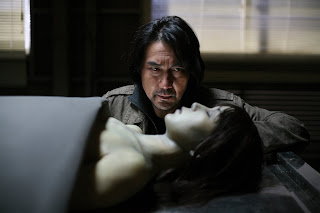
Retribution (Sakebi). 2006. Written and directed by Kiyoshi Kurosawa. Produced by Takashige Ichise. Cinematography by Akiko Ashizawa. Edited by Nobuyuki Takahashi. Music by Kuniaki Haishima.
Cast: Koji Yakusho (Yoshioka), Manami Konishi (Harue), Tsuyoshi Ihara (Detective Miyaji), Riona Hazuki (Woman in Red), Jo Odagiri (Dr. Takagi), Ryo Kase (Man on a work boat), Hiroyuki Hirayama (Young detective Sakurai).
Kiyoshi Kurosawa has been one of the most consistently interesting stylists in Japanese cinema. His films can be superficially associated with the “J-Horror” genre, but anyone familiar with his work knows that much of it goes far beyond this catch-all label. His main strength is that he has not been bound to conventional narrative, and in using his adopted genre as a framework, he has been able to experiment greatly within this form to create a unique cinematic space of moody and intriguing images. In his finest work, including Cure, Pulse, Charisma, and Barren Illusion, Kurosawa offers haunting images that resonate well beyond initial viewings. These qualities extend to his ventures outside the genre, such as License to Live and Bright Future.
Unfortunately, Kurosawa seems to have hit something of a rut lately. His last film, Loft, was a disappointment, even though at first glance it contains many of the elements of his previous work: the somber, unsettling mood; the often baffling and near-incomprehensible occurrences, often concerning the fluidity between the worlds of the living and the dead. While diverting at first viewing, Loft left the impression of being a pale retread of much better earlier work.
However, it pains me to report that his latest film, Retribution, is an even bigger and more serious misfire. Just like Loft, everything familiar to Kurosawa’s films is present and accounted for, including his regular lead actor Koji Yakusho, as a detective investigating a serial killer case. And this is exactly the problem. Everything is far too familiar, both from Kurosawa’s own films (much of it, including a crucial plot point revealed late in the film, feels like a remake of Cure), and other clichéd tropes of J-Horror, such as floating female ghosts (the one in this film often lets out an ear-splitting scream).
In Retribution, detective Yoshioka (Yakusho) is called to investigate a series of murders occurring around a construction site. The victims have all been drowned in saltwater, but strangely, all the murders occur far from any saltwater source. He lives alone in a ramshackle apartment, and is often visited by Harue (Manami Konishi), a mysterious young woman whose relationship to Yoshioka is initially ambiguous. We are unsure whether to sympathize with this character, since the film plays with a well-worn idea in this genre, intentionally making us question whether the detective himself has committed these murders. In the film, we see at least two other murders occur, by two different characters, using the same M.O. Again, not to give too much away, if you’ve already seen Cure, it’s easy to guess how these murders are connected to the central case.
The most disheartening aspect of Retribution is the rote and earth-bound quality of the proceedings. What gives Kurosawa’s films their special resonance is the free space he gives himself to explore such themes as alienation and loneliness which gain their power from not being tethered to a conventional plot. However, in this case everything is explained and rationalized away, as if ticking off items on a checklist. Also, there seems to be an odd lack of engagement with the material on Kurosawa’s part. This may be due to the fact that his producer is Takashige Ichise, responsible for the most popular and archetypal examples of recent Japanese horror (Ju-on, Ring, Dark Water). The tension between their disparate sensibilities, however intriguing a concept it may have seemed on paper, definitely works to the detriment of this production. The lyrical visual quality of Kurosawa’s previous works comes through here and there, especially in the scenes in the abandoned sanitarium that serves a crucial site in the film. Also, Kurosawa seems to be making some point about the eagerness of Japanese society to bury the past, indicated by the constant construction and destruction depicted in the film. But this theme remains undeveloped, itself buried in the film’s insistence in shackling everything to its derivative plot.
In short, Retribution is probably Kurosawa’s worst film yet. For other filmmakers, this would be a not-bad effort, but Kurosawa is capable of, and has achieved, so much more. An escape from the J-Horror ghetto, on the order of Bright Future or License to Live, is sorely called for. Let’s hope he can break out of this stagnation with his next film.










